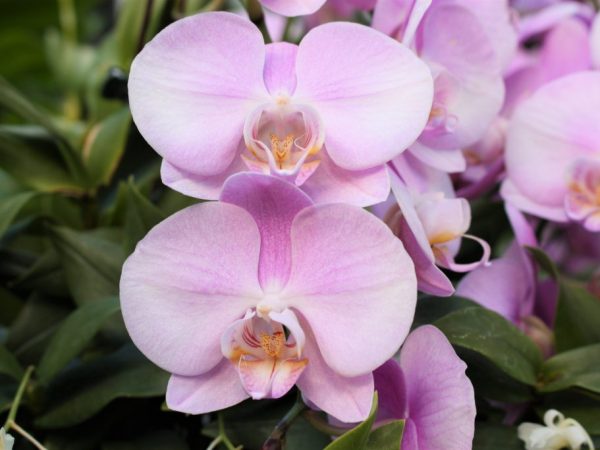Description of Legato butterfly orchid
The Legato Orchid (or Legato butterfly) belongs to the Orchid family. The variety takes its origin from the countries of the Malay Archipelago, in natural conditions it is also found in the mountain forests of the Philippines and on the humid plains of Australia.

Description of Legato butterfly orchid
Description of the variety
Phalaenopsis Legato has large flowers (6-7 cm) with pearlescent pink, yellow, lilac and gold shades. The flowers are silky in texture. The height of an adult plant reaches 60-70 cm.
The life of an orchid lasts on average 10-15 years, and to maintain it it is necessary to renew it by vegetative propagation.
Growing
The cultivation of phalaenopsis must be treated responsibly, because this plant needs careful control.
Transparent pots are better for orchids, which will not restrict root photosynthesis. In the dark, the butterfly needs light, because in their homeland the daylight hours are much longer. Watering is carried out on top of the substrate.
Landing
Planting many varieties of orchids requires soil with few inert materials and adequate aeration. To regulate moisture, sphagnum moss should be planted in the soil. The optimal size of the pot should correspond to the root system and not limit it, another 2-3 cm should be left in stock, because orchids prefer a little cramped space.
For propagation by seeds, they are first sterilized and a nutrient medium from agar-agar is created, and protocorm elements are added according to Knudson's recipe. Further sowing is carried out over steam or after soaking in a solution of bleach.
It is simpler to reproduce by stem offspring, which, within six months, build up the root system on the mother's body. Then the vegetative parts are planted in moist soil.
Care

We water only with warm water
At temperatures exceeding 35C, the Legato Orchid should be immediately transferred to another place with cooler air, and the leaves and roots should be sprayed with warm water.
The optimal temperature range in summer is from 20 to 30 ° C, in winter - from 18 to 25 ° C. The orchid grows well in a semi-shaded area, but still needs periodic soft and relatively bright lighting.
It is important to remove excess moisture from the rosette of the leaves of the plant. During the period of active growth, the substrate should be moderately moist, periodically it should be dried. For Phalaenopsis, watering with soft water at room temperature is suitable. After the winter cold and flowering period, watering is somewhat limited. To normalize the humidity regime, add ceramite or gravel to the pan of the pot. Phalaenopsis cannot be sprayed in the cold.
From March to September, when the butterfly is actively blooming, it is watered every 10 days with a solution for complex soil fertilization, using half the dosage indicated on the package.
Phalaenopsis rarely needs a transplant, but only with insufficient volume or an obsolete substrate, and this usually happens no more than once every two years and in the spring.It will be beneficial for the plant to enrich the soil with pieces of pine bark, sphagnum moss and charcoal.
Diseases and pests
The main diseases are fusarium and gray rot. They are treated with modern drugs.
Fusarium is characterized by an infectious fungal infection of the root system by moldy microorganisms, then the stems and leaves. In this case, the affected area changes color and is pressed in, fungal spores can be found.
Gray rot occurs as a result of improper plant care, including low temperature and high humidity, as well as irrational application of fertilizers, especially nitrogen fertilizers.
There are other, no less common, Orchid diseases.
- Burns occur due to the wrong lighting regime, to which the plant must be accustomed. A plant that stays in a shaded place for a long time, if it is suddenly moved under a bright light, can get severe thermal burns. They can also arise from oversaturated artificial lighting.
- Watering errors also provoke the appearance of leaf and tuber rot when turgor pressure is lost. To avoid this, the soil must be periodically dried.
- With prolonged contact with water, edema forms on the flower, especially at low air temperatures. In the cold season, you need to carefully remove wet spots from the surface of plants and soil.
- Upon contact with cold air, phalaenopsis tissues get frostbite. Because They cannot be restored; all dying parts must be removed with a sterile blade, up to living tissue.
- An incorrectly selected concentration of fertilizers immediately affects: inhibition of metabolic processes is observed, as well as loss of turgor and wilting of leaves, burning of roots. It is useful to take a hot shower once a week to wash out accumulated salts and tone up growth processes.
- Anthracnose - fungal black spots that form dents on the leaves and pseudotubers. It occurs due to high humidity and water stagnation.
Prophylaxis
Prevention measures include:
- maintaining optimal temperature, humidity and lighting indicators;
- timely fertilizing of the soil;
- periodic inspections of the plant;
- regular spraying;
- periodic treatment with drugs.
Conclusion
Despite the finickyness of orchids and the peculiarities of their cultivation, with proper care, you will definitely receive a chic flower as a reward, worthy of the attention of your family and friends, who will definitely want to grow such beauty in their home.


